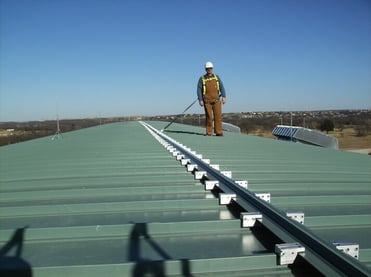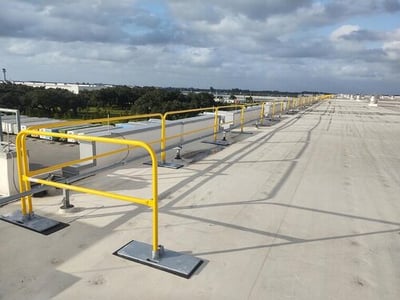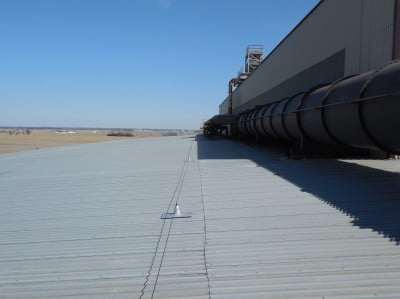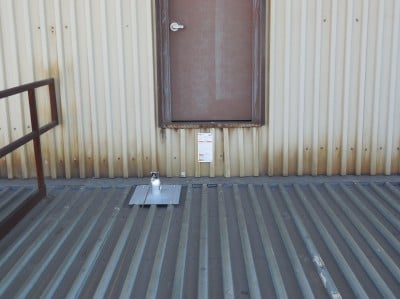When it comes to rooftop fall protection, a wide range of options can ensure worker safety and OSHA compliance, including horizontal lifelines and rooftop guardrail. Choosing from multiple strategies means we can tailor a system to meet your specific needs and budget, but the wealth of choices can be confusing, too.
To better understand your options, first take a closer look at these two common approaches to rooftop fall protection: guardrail and horizontal lifeline systems.
What is a Horizontal Lifeline System?

Horizontal lifeline fall protection entails installing a cable and anchor points to the roof, which can be hooked into using a lanyard and safety harness. The user is then protected from fall hazards. Horizontal lifelines are active fall protection systems and they need precise engineering to ensure safety.
Requirements for horizontal lifeline
Horizontal lifeline has two important requirements:
- It must be strong enough to hold up to the forces of a fall
- It must be engineered so that the user does not strike any object below in the event of a fall
Professional design, engineering and installation ensure that your roof is properly assessed and equipped.
What is Rooftop Guardrail?

Whereas horizontal lifelines are active fall restraints, rooftop guardrail is a passive fall protection system. There is no tying off, hooking in, or other action a user must take to be protected by the system — a user is protected from the moment they step onto the rooftop.
Rooftop guardrail consists of safety railings that are affixed or secured to the roof and can include non-penetrating base plates.
Requirements for rooftop guardrail
Rooftop guardrail has slightly different requirements than horizontal lifelines. Briefly:
- The railings must be able to withstand outward or downward force up to 200 pounds
- The railings must be 42” high
Assess Your Roof
Before discussing the merits and challenges posed by each system type, start by thinking about your roof and, more specifically, the application. Our trained safety engineers begin with basic questions, such as:
- What is the pitch of the roof?
- What is the composition of the roofing material?
- What is the desired coverage area?
- What is your budget?
These and other answers will help inform the decision-making process.
Fall Protection System Selection: An Example
Let’s explore the process used to select a fall protection system by using an Indiana steel plant as an example.
This client’s maintenance personnel needed fall protection to safely access and maintain rooftop exhaust fans and a water cooling tower. Recall that OSHA’s part 1910 standards contain general-industry fall protection provisions which require fall protection for employees working at heights in excess of four feet. However, the regulations do not specify a particular system type.
Consider the roof
For flat and low-slope commercial roof applications, freestanding portable guardrail systems are often ideal. This is because guardrail installations require no rooftop penetrations, and you can eliminate the PPE, training and inspection/re-certification requirements associated with engineered lifeline systems.
The pitch of this client’s roof (2/12) did not rule out portable guardrail as an option, but the application required fall protection for a large work area, indicating horizontal lifelines could be the better choice from a cost standpoint.
Consider the area covered
Horizontal lifelines are considered “engineered fall protection systems”, and as such, one might expect a horizontal lifeline fall arrest system to carry a higher price tag, but this is not always the case, especially with larger installations. Installing perimeter guardrail on larger rooftops (1/4 mile or more in some instances) requires a sizable investment that not all companies are willing to make. The sheer size of the steel plant’s designated work area was ideal for a horizontal lifeline.

Consider the anchor points required
One of the more demanding engineering aspects of a horizontal lifeline installation is determining the anchor point attachment methodology.
In previous posts, we noted that selecting an anchor point method for a horizontal lifeline is dictated by roof pitch. Roofs with steep pitches in excess of 4/12 typically require rigid post anchors while rooftops with pitches less than 4/12 are well-suited for tip-over style anchor connections.
Here the 2/12 pitch corrugated sheet metal roof was ideal for riveted tip-over posts. Tip-over post technology is minimally invasive and far less prone to leaks than rigid posts attached to the structural steel beneath the roof deck.

Consider user access
The finished installation spanning 400 feet features continuous pass-through and accommodates up to three users. Maintenance personnel have direct access to the horizontal lifeline system from the moment they step foot on the roof.
Consider your future budget
When comparing relative costs of rooftop guardrail and horizontal lifeline solutions, it is also important to think about your budget post-installation. Guardrail typically carries a one-time purchase and installation cost. There is no need for annual inspections, and the system only needs repair if the railing is damaged.
A horizontal lifeline, however, requires annual inspection and re-certification. When you factor in these costs, the cost of a horizontal lifeline CAN meet or exceed that of a guardrail installation, but the price differential for larger rooftops narrows significantly only after many years.
Choose a Reliable Fall Protection Partner
Remember, infrequent rooftop access does not excuse an employer from providing fall protection for maintenance personnel. Whether your staff accesses the rooftop once a year or once a day, the OSHA standards are clear—and non-compliance penalties are significant.
The best way to avoid sizable fines, injuries and possible fatalities is to partner with a fall protection company that understands the complexities of rooftop fall protection.
To learn more, download our white paper on selecting the proper fall protection company, or contact one of our fall protection specialists.

